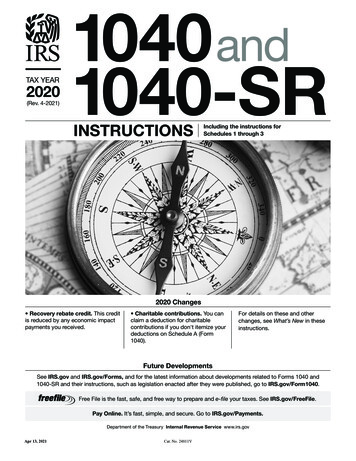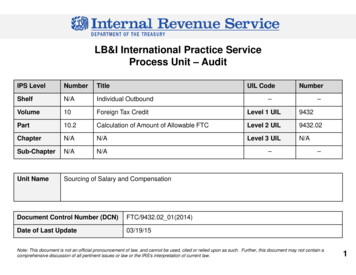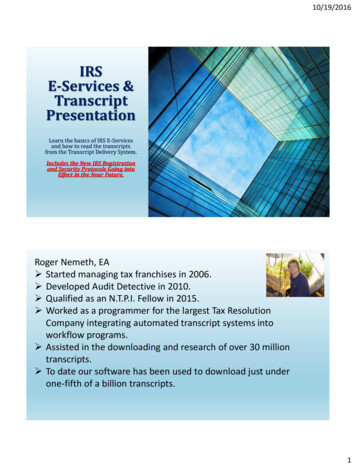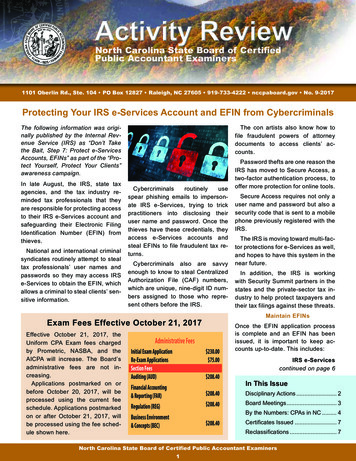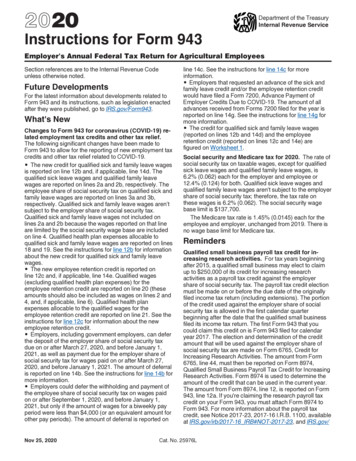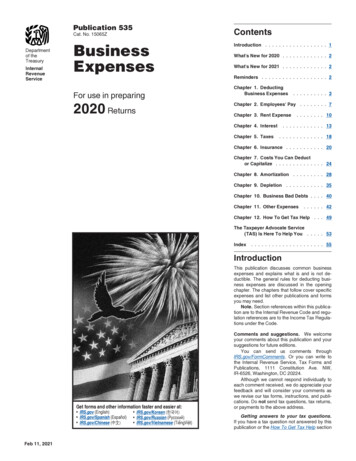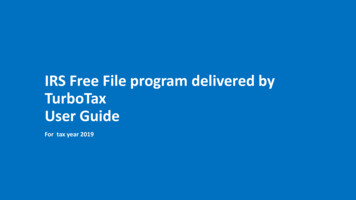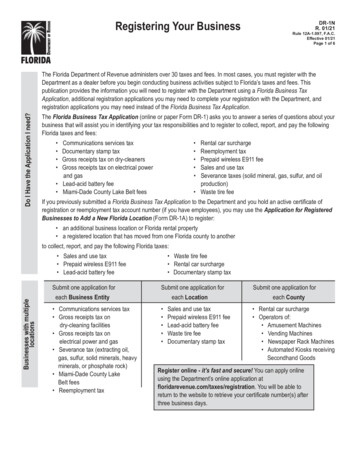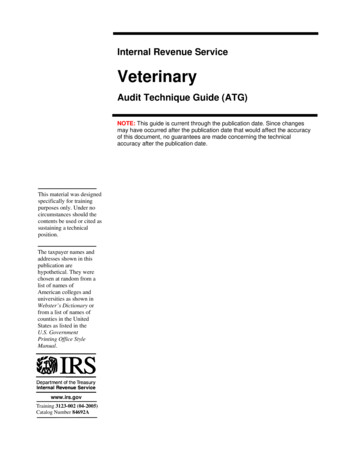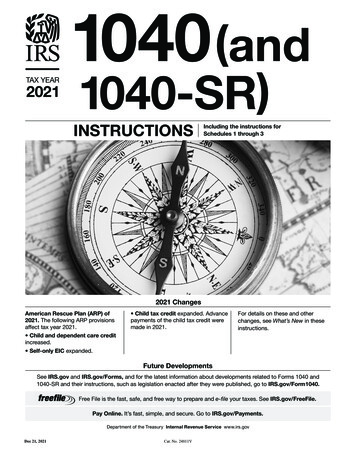
Transcription
TAX YEAR20211040 (and1040-SR)INSTRUCTIONSRIncluding the instructions forSchedules 1 through 32021 ChangesAmerican Rescue Plan (ARP) of2021. The following ARP provisionsaffect tax year 2021. Child and dependent care creditincreased. Self-only EIC expanded. Child tax credit expanded. Advancepayments of the child tax credit weremade in 2021.For details on these and otherchanges, see What’s New in theseinstructions.Future DevelopmentsSee IRS.gov and IRS.gov/Forms, and for the latest information about developments related to Forms 1040 and1040-SR and their instructions, such as legislation enacted after they were published, go to IRS.gov/Form1040.Free File is the fast, safe, and free way to prepare and e-file your taxes. See IRS.gov/FreeFile.Pay Online. It’s fast, simple, and secure. Go to IRS.gov/Payments.Department of the Treasury Internal Revenue Service www.irs.govDec 21, 2021Cat. No. 24811V
Table of ContentsContentsDepartmentof theTreasuryInternalRevenueServicePageWhat's New . . . . . . . . . . . . . . . . . . . . . . . . 6Filing Requirements . . . . . . . . . . . . . . . . . . 9Do You Have To File? . . . . . . . . . . . . . . 9When and Where Should You File? . . . . . 9Line Instructions for Forms 1040 and1040-SR . . . . . . . . . . . . . . . . .Filing Status . . . . . . . . . . . . . .Name and Address . . . . . . . . . .Social Security Number (SSN) . .Dependents, Qualifying Child forChild Tax Credit, and Credit forOther Dependents . . . . . . . . .Income . . . . . . . . . . . . . . . . . .Total Income and Adjusted GrossIncome . . . . . . . . . . . . . . . .Tax and Credits . . . . . . . . . . . .Payments . . . . . . . . . . . . . . . .Refund . . . . . . . . . . . . . . . . . .Amount You Owe . . . . . . . . . . .13131515ContentsPageSign Your Return . . . . . . . . . . . . . . . . 63Assemble Your Return . . . . . . . . . . . . 642021 Tax Table . . . . . . . . . . . . . . . . . . . . 65General Information . . . . . . . . . . . . . . . . . 78Refund Information . . . . . . . . . . . . . . . . . . 83Instructions for Schedule 1 . . . . . . . . . . . . . 84Instructions for Schedule 2 . . . . . . . . . . . . . 96Instructions for Schedule 3 . . . . . . . . . . . . 101. . . . . 18. . . . . 23.-2-3030375861Tax Topics . . . . . . . . . . . . . . . . . . . . . . 105Disclosure, Privacy Act, and PaperworkReduction Act Notice . . . . . . . . . . . . 107Major Categories of Federal Income andOutlays for Fiscal Year 2020 . . . . . . . 109Index . . . . . . . . . . . . . . . . . . . . . . . . . . 111
Form 1040 and 1040-SRHelpful HintsFor 2021, you will use Form 1040 or, if you were born before January 2, 1957, you have the option to useForm 1040-SR.You may only need to file Form 1040 or 1040-SR and none of the numbered schedules, Schedules 1 through3. However, if your return is more complicated (for example, you claim certain deductions or credits or oweadditional taxes), you will need to complete one or more of the numbered schedules. Below is a general guideto which schedule(s) you will need to file based on your circumstances. See the instructions for the schedulesfor more information.If you e-file your return, you generally won't notice much of a change and the software you use will generallydetermine which schedules you need.IF YOU.THEN USE.Have additional income, such as business or farm income orloss, unemployment compensation, prize or award money, orgambling winnings.Schedule 1, Part IHave any deductions to claim, such as student loan interest,self-employment tax, or educator expenses.Schedule 1, Part IIOwe alternative minimum tax (AMT) or need to make anexcess advance premium tax credit repayment.Schedule 2, Part IOwe other taxes, such as self-employment tax, householdemployment taxes, additional tax on IRAs or other qualifiedretirement plans and tax-favored accounts.Schedule 2, Part IICan claim a nonrefundable credit (other than the nonrefundablechild tax credit or the credit for other dependents), such as theforeign tax credit, education credits, or general business credit.Schedule 3, Part ICan claim a refundable credit (other than the earned incomecredit, American opportunity credit, refundable child tax credit,additional child tax credit, or recovery rebate credit), such as thenet premium tax credit, health coverage tax credit, or qualifiedsick and family leave credits from Schedule H or Schedule SE.Have other payments, such as an amount paid with a request foran extension to file or excess social security tax withheld.-3-Schedule 3, Part II
The Taxpayer Advocate Service Is Here To Help YouWhat is the Taxpayer Advocate Service?The Taxpayer Advocate Service (TAS) is an independent organization within the Internal Revenue Service (IRS) that helpstaxpayers and protects taxpayer rights. TAS strives to ensure that every taxpayer is treated fairly and that you know andunderstand your rights under the Taxpayer Bill of Rights.What can TAS do for you?TAS can help you if your tax problem is causing a financial difficulty, you've tried and been unable to resolve your issue withthe IRS, or you believe an IRS system, process, or procedure just isn't working as it should. And the service is free. If youqualify for TAS assistance, you will be assigned to one advocate who will work with you throughout the process and will doeverything possible to resolve your issue. TAS can help you if: Your problem is causing a financial difficulty for you, your family, or your business. You face (or your business is facing) an immediate threat of adverse action. You’ve tried to contact the IRS but no one has responded, or the IRS hasn’t responded by the date promised.How can you reach TAS?We have offices in every state, the District of Columbia, and Puerto Rico. To find your advocate’s number: Go to TaxpayerAdvocate.IRS.gov/contact-us; Download Publication 1546, Taxpayer Advocate Service - We Are Here to Help You, available at IRS.gov/Forms-Pubs. Ifyou do not have internet access, you can call the IRS toll free at 800-829-3676 and ask for a copy of Publication 1546; Check your local directory; or Call TAS toll free at 877-777-4778.How can you learn about your taxpayer rights?The Taxpayer Bill of Rights describes ten basic rights that all taxpayers have when dealing with the IRS. The TAS Tax Toolkitat TaxpayerAdvocate.IRS.gov can help you understand what these rights mean to you and how they apply. These are your rights.Know them.How else does the Taxpayer Advocate Service help taxpayers?TAS works to resolve large-scale problems that affect many taxpayers. If you know of one of these broad issues, please report itto TAS at IRS.gov/SAMS. Be sure not to include any personal taxpayer information.Low Income Taxpayer Clinics Help TaxpayersLow Income Taxpayer Clinics (LITCs) are independent from the Internal Revenue Service (IRS) and the Taxpayer AdvocateService (TAS). LITCs represent individuals whose income is below a certain level and who need to resolve tax problems withthe IRS. LITCs can represent taxpayers in audits, appeals, and tax collection disputes before the IRS and in court. In addition,LITCs can provide information about taxpayer rights and responsibilities in different languages for individuals who speakEnglish as a second language. Services are offered for free or a small fee. For more information or to find an LITC near you, seethe LITC page at TaxpayerAdvocate.IRS.gov/LITCMap or IRS Publication 4134, Low Income Taxpayer Clinic List. Thispublication is available online at IRS.gov/Forms-Pubs or by calling the IRS toll free at 800-829-3676.Suggestions for Improving the IRSTaxpayer Advocacy PanelTaxpayers have an opportunity to provide direct feedback to the Internal Revenue Service (IRS) through the Taxpayer AdvocacyPanel (TAP). The TAP is a Federal Advisory Committee comprised of an independent panel of citizen volunteers who listen totaxpayers, identify taxpayers' systemic issues, and make suggestions for improving IRS customer service. Contact TAP atImproveIRS.org.-4-
Affordable Care Act — What You Need To KnowRequirement To Reconcile Advance Payments of the Premium Tax CreditThe premium tax credit helps pay premiums for health insurance purchased from the Marketplace. Eligibleindividuals may have advance payments of the premium tax credit made on their behalf directly to the insurancecompany.If you or a family member enrolled in health insurance through the Marketplace and advance payments of thepremium tax credit were made to your insurance company to reduce your monthly premium payment, you must attachForm 8962 to your return to reconcile (compare) the advance payments with your premium tax credit for the year.The Marketplace is required to send Form 1095-A by January 31, 2022, listing the advance payments and otherinformation you need to complete Form 8962.1. You will need Form 1095-A from the Marketplace.2. Complete Form 8962 to claim the credit and to reconcile your advance credit payments.3. Include Form 8962 with your Form 1040, Form 1040-SR, or Form 1040-NR. (Don’t include Form 1095-A.)Health Coverage ReportingIf you or someone in your family was an employee in 2021, the employer may be required to send you Form1095-C. Part II of Form 1095-C shows whether your employer offered you health insurance coverage and, ifso, information about the offer. You should receive Form 1095-C by early February 2022. This information maybe relevant if you purchased health insurance coverage for 2021 through the Health Insurance Marketplaceand wish to claim the premium tax credit on Schedule 3, line 9. However, you don’t need to wait to receive thisform to file your return. You may rely on other information received from your employer. If you don’t wish to claimthe premium tax credit for 2021, you don’t need the information in Part II of Form 1095-C. For more informationon who is eligible for the premium tax credit, see the Instructions for Form 8962.Reminder: Health care coverage. If you need health care coverage, go to www.HealthCare.gov to learn abouthealth insurance options for you and your family, how to buy health insurance, and how you might qualify to getfinancial assistance to buy health insurance.-5-
What's NewDue date of return. File Form 1040 or1040-SR by April 18, 2022. The duedate is April 18, instead of April 15, because of the Emancipation Day holidayin the District of Columbia – even if youdon’t live in the District of Columbia. Ifyou live in Maine or Massachusetts, youhave until April 19, 2022. That is because of the Patriots' Day holiday inthose states.Tuition and fees deduction not available. The tuition and fees deduction isnot available after 2020. Instead, the income limitations for the lifetime learning credit have been increased. SeeForm 8863 and its instructions.Economic impact payment—EIP 3.Any economic impact payment you received is not taxable for federal incometax purposes, but will reduce your recovery rebate credit.2021 Recovery rebate credit. Thiscredit is figured like last year's economicimpact payment, EIP 3, except eligibility and the amount of the credit are basedon your tax year 2021 information. Seethe instructions for line 30 and the Recovery Rebate Credit Worksheet to figure your credit amount.Standard deduction amount increased. For 2021, the standard deduction amount has been increased for allfilers. The amounts are: Single or Married filing separately— 12,550. Married filing jointly or Qualifying widow(er)— 25,100. Head of household— 18,800.Virtual currency. If, in 2021, you engaged in a transaction involving virtualcurrency, you will need to answer “Yes”to the question on page 1 of Form 1040or 1040-SR. See Virtual Currency, later,for information on transactions involving virtual currency. Do not leave thisfield blank. The question must be answered by all taxpayers, not just taxpayers who engaged in a transaction involving virtual currency.Credits for sick and family leave forcertain self-employed individuals.For information about any additional changes to the 2021 tax law or any other developments affecting Form 1040 or 1040-SR or the instructions, go to IRS.gov/Form1040.The Families First Coronavirus Response Act (FFCRA) helped self-employed individuals affected by coronavirus by providing paid sick leave andpaid family leave credits equivalent tothose that employers are required to provide their employees for qualified sickleave wages and qualified family leavewages. The COVID-related Tax ReliefAct of 2020 extended the period duringwhich individuals can claim these credits. For more information, see the instructions for Form 7202 and Schedule3, line 13b.Extension and expansion of credits forsick and family leave. The AmericanRescue Plan Act of 2021, enacted onMarch 11, 2021 (ARP) provides thatcertain self-employed individuals canclaim credits for up to 10 days of “paidsick leave,” and up to 60 days of “paidfamily leave,” if they are unable to workor telework due to circumstances relatedto coronavirus. Self-employed individuals may claim these credits for the period beginning on April 1, 2021, and ending September 30, 2021. For moreinformation, see the instructions forForm 7202 and Schedule 3, line 13h.Form 9000, Alternative Media Preference. Beginning in 2021, taxpayerswith print disabilities can use Form9000, Alternative Media Preference, toelect to receive notices from the IRS inan alternative format including Braille,large print, audio, and electronic. Youcan attach Form 9000 to your Form1040 or 1040-SR or you can mail it separately. For more information, see Form9000.All taxpayers now eligible for IdentityProtection PIN. Beginning in 2021, theIRS Identity Protection PIN (IP PIN)Opt-In Program has been expanded toall taxpayers who can properly verifytheir identity. An IP PIN helps preventyour social security number from beingused to file a fraudulent federal incometax return. You can use the Get An IPPIN tool on IRS.gov to request an IPPIN, file Form 15227 if your income is-6- 72,000 or less, or make an appointmentto visit a Taxpayer Assistance Center.Direct deposit now available for returns filed late. You can now receive adirect deposit of your refund even if youfile your 2021 return after November 30,2022.Expanded dependent care assistance.ARP expanded the child and dependentcare tax credit for 2021 by making it refundable for certain taxpayers and making it larger. For 2021, the dollar limiton qualifying expenses increases to 8,000 for one qualifying person and 16,000 for two or more qualifying persons. The rules for calculating the credithave also changed; the percentage ofqualifying expenses eligible for thecredit has increased, along with the income limit at which the credit beginsphasing out. Additionally, for taxpayerswho receive dependent care benefitsfrom their employer, the dollar limit ofthe exclusion amount increases for 2021.For more information, see the Instructions for Form 2441 and Pub. 503.Child tax credit. Under ARP, the childtax credit has been enhanced for 2021.The child tax credit has been extendedto qualifying children under age 18. Depending on modified adjusted gross income, you may receive an enhancedcredit amount of up to 3,600 for a qualifying child under age 6 and up to 3,000 for a qualifying child over age 5and under age 18. The enhanced creditamount begins to phase out where modified adjusted gross income exceeds 150,000 in the case of a joint return orsurviving spouse, 112,500 in the caseof a head of household, and 75,000 inall other cases.If you (or your spouse if filing jointly) lived in the United States for morethan half the year, the child tax creditwill be fully refundable even if you don'thave earned income. If you don't meetthis residency requirement, your childtax credit will be a combination of anonrefundable child tax credit and a refundable additional child tax credit, aswas the case in 2020. The credit for oth-
er dependents has not been enhancedand is figured as it was in 2020.Changes to Schedule 8812. Because ofthe changes made by ARP, detailed discussion of the child tax credit, and howto figure your child tax credit and creditfor other dependents, which were previously part of these instructions, has beenmoved to the Instructions for Schedule8812 (Form 1040). If you are claimingthe nonrefundable child tax credit, refundable child tax credit, additionalchild tax credit, or credit for other dependents, complete Schedule 8812 andattach it to your Form 1040 or 1040-SR.Premium tax credit (PTC). ARP expanded the PTC by eliminating the limitation that a taxpayer's household income may not exceed 400% of theFederal Poverty Line and generally increases the credit amounts. In addition,in 2021, if you receive unemploymentcompensation, you are generally eligibleto claim the PTC if you meet the otherrequirements. For more information, seePub. 974 and Form 8962 and its instructions.Changes to the earned income credit(EIC). For 2021, the following changeshave been made to the EIC. EIC rules for taxpayers withouta qualifying child. Special rules applyif you are claiming the EIC without aqualifying child. In these cases, the minimum age has been lowered to age 19except for specified students who mustbe at least age 24 at the end of the year.However, the applicable minimum ageis lowered further for former fosteryouth and qualified homeless youth toage 18. Additionally, you no longer needto be under age 65 to claim the EICwithout a qualifying child. EIC rules for taxpayers with aqualifying child. If you are claiming theEIC with a qualifying child, you shouldfollow the rules that apply to filers witha qualifying child or children when determining whether you are eligible toclaim the EIC even if your qualifyingchild hasn't been issued a valid SSN onor before the due date of your return (including extensions). However, when determining the amount of EIC that youare eligible to claim on your return, youshould follow the rules that apply to taxpayers who do not have a qualifyingchild. Phaseout amounts increased.The amount of the credit has been increased and the phaseout income limitsat which you can claim the credit havebeen expanded. Rules for separated spouses. Ifyou are married but don't file a joint return, you may qualify to claim the EIC ifyou live with a qualifying child for morethan half the year and either live apartfrom your spouse for the last 6 monthsof 2021 or are legally separated according to your state law under a written separation agreement or a decree of separate maintenance and do not live in thesame household as your spouse at theend 2021. Investment income limit increased. The amount of investment income you can receive and still be eligible to claim the EIC has increased to 10,000. Prior year (2019) earned income.You can elect to use your 2019 earnedincome to figure your 2021 earned income credit if your 2019 earned incomeis more than your 2021 earned income.See the instructions for line 27a.File Schedule EIC (Form 1040) if youhave a qualifying child. If you have atleast one child who meets the conditionsto be your qualifying child for purposes-7-of claiming the EIC, complete and attach Schedule EIC to your Form 1040 or1040-SR even if that child doesn't havea valid SSN. For more information, including how to complete Schedule EICif your qualifying child doesn't have avalid SSN, see the line 27a instructionsand Schedule EIC.Forgiveness of Paycheck ProtectionProgram (PPP) Loans. The forgiveness of a PPP Loan creates tax-exemptincome, so you don't need to report theincome on Form 1040 or 1040-SR, butyou do need to report certain information related to your PPP Loan. To findout how to report information related toyour PPP Loan, see Forgiveness of Paycheck Protection Program (PPP) Loans,under Income, later.Identityverification. TheIRSlaunched an improved identity verification and sign-in process that enablesmore people to securely access and useIRS online tools and applications. Toprovide verification services, the IRS isusing ID.me, a trusted technology provider. The new process is one more stepthe IRS is taking to ensure that taxpayerinformation is provided only to the person who legally has a right to the data.Taxpayers using the new mobile-friendly verification procedure can gain entryto existing IRS online services such asthe Child Tax Credit Update Portal, Online Account, Get Transcript Online, Getan Identity Protection PIN (IP PIN), andOnline Payment Agreement. AdditionalIRS applications will transition to thenew method over the next year. Eachonline service will also provide information that will instruct taxpayers on thesteps they need to follow for access tothe service. You can also seeIR-2021-228 for more information.
Free Software Options for Doing Your TaxesWhy have 49 million Americans used Free File? Security—Free File uses the latest encryption technology to safeguard your information. Flexible Payments—File early; pay by April 18, 2022 (for most people). Greater Accuracy—Fewer errors mean faster processing. Quick Receipt—Get an acknowledgment that your return was received and accepted. Go Green—Reduce the amount of paper used. It’s Free—through IRS.gov/FreeFile. Faster Refunds—Join the eight in 10 taxpayers who get their refunds faster by usingdirect deposit and e-file.Do Your Taxes for FreeIf your adjusted gross income was 73,000 or less in 2021, you can use free tax software to prepare and e-file your tax return.Earned more? Use Free File Fillable Forms.Free File. This public–private partnership, between the IRS and tax software providers, makes approximately a dozenbrand-name commercial software products and e-file available for free. Seventy percent of the nation’s taxpayers are eligible.Just visit IRS.gov/FreeFile for details. Free File combines all the benefits of e-file and easy-to-use software at no cost. Guidedquestions will help ensure you get all the tax credits and deductions you are due. It’s fast, safe, and free.You can review each software provider’s criteria for free usage or use an online tool to find which free software products matchyour situation. Some software providers offer state tax return preparation for free.Free File Fillable Forms. The IRS offers electronic versions of IRS paper forms that can also be e-filed for free. Free FileFillable Forms is best for people experienced in preparing their own tax returns. There are no income limitations. Free FileFillable Forms does basic math calculations. It supports only federal tax forms.Free Tax Help Available NationwideVolunteers are available in communities nationwide providing free tax assistance to low-to-moderate income (generally under 58,000 in adjusted gross income) and elderly taxpayers (age 60 and older). At selected sites, taxpayers can input andelectronically file their own tax return with the assistance of an IRS-certified volunteer.See How To Get Tax Help near the end of these instructions for additional information or visit IRS.gov (Keyword: VITA) for aVITA/TCE site near you!IRS.gov is the gateway to all electronic services offered by the IRS, as well as the spot to download forms at IRS.gov/Forms.Make your tax payments online—it’s easy.You can make payments online, by phone, or from a mobile device. Paying online is safe and secure; itputs you in control of paying your tax bill and gives you peace of mind. You determine the paymentdate, and you will receive an immediate confirmation from the IRS. Go to IRS.gov/Payments to see allyour online payment options.-8-
FilingRequirementsDo You Have ToFile?Use Chart A, B, or C to see if you mustfile a return. U.S. citizens who lived inor had income from a U.S. possessionshould see Pub. 570. Residents of PuertoRico can use Tax Topic 901 to see ifthey must file.Even if you do not otherwiseTIP have to file a return, youshould file one to get a refundof any federal income tax withheld. Youshould also file if you are eligible forany of the following credits. Earned income credit.Refundable child tax credit or additional child tax credit. American opportunity credit. Credit for federal tax on fuels. Premium tax credit. Health coverage tax credit. Recovery rebate credit. Credits for sick and family leave. Child and dependent care credit.See Pub. 501 for details. Also seePub. 501 if you do not have to file butreceived a Form 1099-B (or substitutestatement).Requirement to reconcile advancepayments of the premium tax credit.If you, your spouse with whom you arefiling a joint return, or a dependent wasenrolled in coverage through the Marketplace for 2021 and advance paymentsof the premium tax credit were made forthis coverage, you must file a 2021 return and attach Form 8962. You (orwhoever enrolled you) should have received Form 1095-A from the Marketplace with information about your coverage and any advance payments.You must attach Form 8962 even ifsomeone else enrolled you, your spouse,or your dependent. If you are a dependent who is claimed on someone else'sThese rules apply to all U.S. citizens, regardless of where they live, and resident aliens.Have you tried IRS e-file? It's the fastest way to get your refundand it's free if you are eligible. Visit IRS.gov for details.2021 return, you do not have to attachForm 8962.Exception for certain children underage 19 or full-time students. If certainconditions apply, you can elect to include on your return the income of achild who was under age 19 at the endof 2021 or was a full-time student underage 24 at the end of 2021. To do so, useForm 8814. If you make this election,your child doesn't have to file a return.For details, use Tax Topic 553 or seeForm 8814.A child born on January 1, 1998, isconsidered to be age 24 at the end of2021. Do not use Form 8814 for such achild.Resident aliens. These rules also applyif you were a resident alien. Also, youmay qualify for certain tax treaty benefits. See Pub. 519 for details.Nonresident aliens and dual-status aliens. These rules also apply if you werea nonresident alien or a dual-status alienand both of the following apply. You were married to a U.S. citizenor resident alien at the end of 2021. You elected to be taxed as a resident alien.See Pub. 519 for details.Specific rules apply to determine if you are a resident alien,CAUTION nonresident alien, or dual-status alien. Most nonresident aliens anddual-status aliens have different filingrequirements and may have to file Form1040-NR. Pub. 519 discusses these requirements and other information tohelp aliens comply with U.S. tax law.!When and WhereShould You File?File Form 1040 or 1040-SR by April 18,2022. The due date is April 18, insteadof April 15, because of the Emancipation Day holiday in the District of Co--9-lumbia – even if you don’t live in theDistrict of Columbia. If you live inMaine or Massachusetts, you have untilApril 19, 2022, because of the Patriots'Day holiday in those states. If you fileafter this date, you may have to pay interest and penalties. See Interest andPenalties, later.If you were serving in, or in supportof, the U.S. Armed Forces in a designated combat zone or contingency operation, you may be able to file later. SeePub. 3 for details.If you e-file your return, there is noneed to mail it. However, if you chooseto mail it instead, filing instructions andaddresses are at the end of these instructions.The chart at the end of these in-TIP structions provides the currentaddress for mailing your return. Use these addresses for Forms1040 or 1040-SR filed in 2022. The address for returns filed after 2022 may bedifferent. See IRS.gov/Form1040 for anyupdates.What if You Can't File onTime?You can get an automatic 6-month extension if, no later than the date your return is due, you file Form 4868. For details, see Form 4868. Instead of filingForm 4868, you can apply for an automatic extension by making an electronicpayment by the due date of your return.An automatic 6-month extension to file doesn't extend theCAUTION time to pay your tax. If youdon’t pay your tax by the original duedate of your return, you will owe intereston the unpaid tax and may owe penalties. See Form 4868.!If you are a U.S. citizen or residentalien, you may qualify for an automaticextension of time to file without filingForm 4868. You qualify if, on the due
date of your return, you meet one of thefollowing conditions. You live outside the United Statesand Puerto Rico and your main place ofbusiness or post of duty is outside theUnited States and Puerto Rico. You are in military or naval service on duty outside the United States andPuerto Rico.This extension gives you an extra 2months to file and pay the tax, but interest will be charged from the original duedate of the return on any unpaid tax.You must include a statement showingthat you meet the requirements. If youare still unable to file your return by theend of the 2-month period, you can getan additional 4 months if, no later thanJune 15, 2022, you file Form 4868. This4-month extension of time to file doesn'textend the time to pay your tax. SeeForm 4868.Private Delivery ServicesIf you choose to mail your return, youcan use certain private delivery servicesdesignated by the IRS to meet the “timely mailing treated as timely filing/paying” rule for tax returns and payments. These private delivery servicesinclude only the following. FedEx First Overnight, FedEx Priority Overnight, FedEx Standard Overnight, FedEx 2 Day, FedEx InternationalNext Flight Out, FedEx InternationalPriority, FedEx International First, andFedEx International Economy. DHL Express 9:00, DHL Express10:30, DHL Express 12:00, DHL Ex-press Worldwide, DHL Express Envelope, DHL Import Express 10:30, DHLImport Express 12:00, and DHL ImportExpress Worldwide. UPS Next Day Air Early A.M.,UPS Next Day Air, UPS Next Day AirSaver, UPS 2nd Day Air, UPS 2nd DayAir A.M., UPS Worldwide ExpressPlus, and UPS Worldwide Express.To check for any updates to the list ofdesig
See IRS.gov and IRS.gov/Forms, and for the latest information about developments related to Forms 1040 and 1040-SR and their instructions, such as legislation enacted after they were published, go to IRS.gov/Form1040. Free File is the fast, safe, and free way to prepare and e- le your
